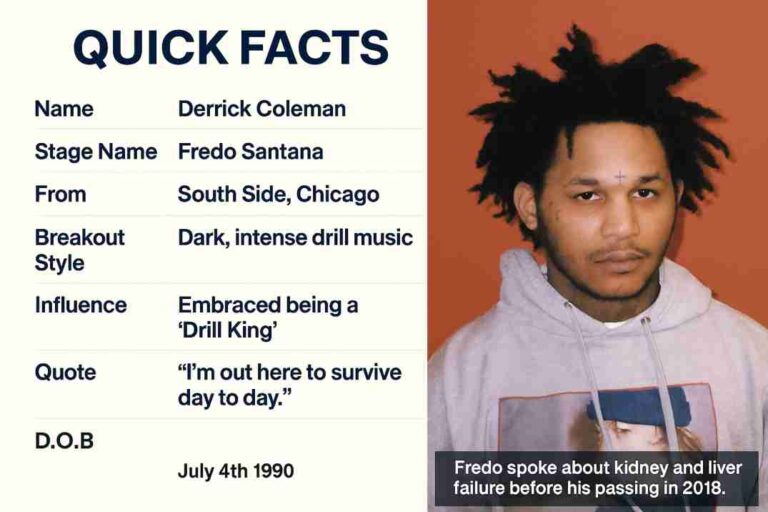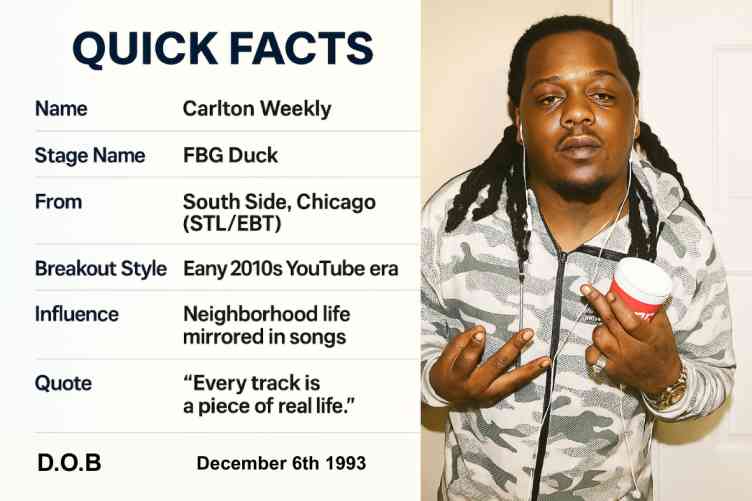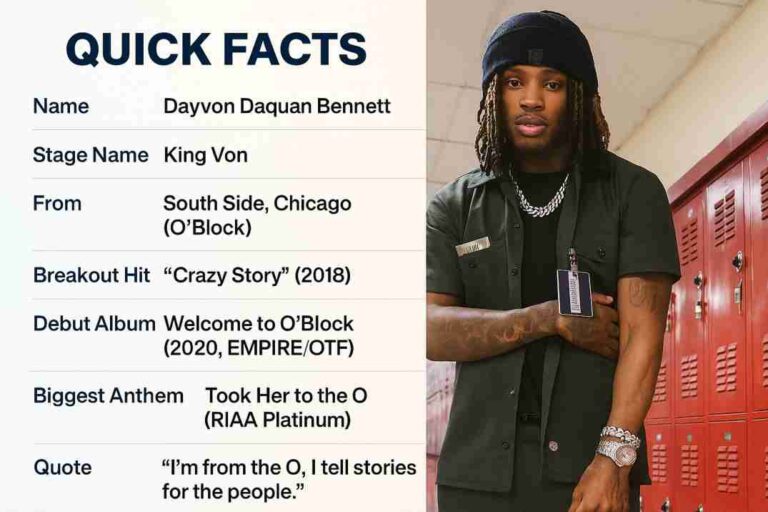| Bio/Wiki | |
|---|---|
| Name | Brandon George Dickinson 1 |
| Stage Names / Nicknames | Lil Bibby, Bibby 2 |
| Date of Birth | July 18, 1994 2 |
| Age (as of Sept 17, 2025) | 31 (derived from July 18, 1994) |
| Zodiac Sign | Cancer (derived from July 18) |
| Nationality | American 2 |
| Hometown | Chicago, Illinois – South Side 2 |
| Physical Stats | |
| Height | ~5’10″–6’1″ (estimated, unconfirmed) |
| Weight | ~170–190 lbs (estimated, unconfirmed) |
| Eye Color | Brown (assumed from media photos) |
| Hair Color | Black (assumed from media photos) |
| Career | |
| Debut Song | Early breakout “Kill Shit” with Lil Herb (2012–2013) and first solo single “How We Move” (2013) 3 |
| Breakout Tape / EP | FC3 The Epilogue EP, Kemosabe Records, 2017 4 |
| Collaborations | |
| Labels / Imprints | Founder – Grade A Productions; previously Kemosabe Records / RCA 9 |
| Signature | Not publicly available |
| Personal Life | |
| Siblings | Brother – George “G Money” Dickinson, Grade A co-founder 10 |
| Education | |
| School | Liberty High School, Chicago – graduated 2015 11 |
| College | Explored computer engineering, discussed enrolling 12 |
| Educational Qualification | High school graduate; college not confirmed 11 |
| Preferences & Interests | |
| Food Habit | Not publicly stated |
| Hobbies | Studio work, basketball, music business 13 |
| Earnings & Assets | |
| Net Worth | Not publicly disclosed; estimates vary 10 |
| Income Sources | Music releases, features, executive work at Grade A Productions |
| Controversy / Notable Moments | |
| Overview | Oversight of Juice WRLD’s posthumous catalog, including protecting “In My Head” from leaks 14 |
| Fun Facts | |
| |
Who is Lil Bibby and what is his real name?
Lil Bibby is Brandon George Dickinson a Chicago rapper who became a label executive.
Lil Bibby whose real name is Brandon George Dickinson is a Chicago born rapper who rose during the early 2010s drill movement before moving into a successful executive role 15 He grew up on the South Side of Chicago and that shaped his raw street centered lyrics. His breakout came with the “Free Crack mixtape” series where his gravelly voice and grounded delivery stood out from other drill artists.
Beyond rap he co founded Grade A Productions label that signed global stars like Juice WRLD and The Kid Laroi. This shift turned him from a rising rapper into a builder of international talent.
Where did Lil Bibby grow up and how did Chicago shape his music?

Lil Bibby grew up on the South Side of Chicago and the city shaped his voice and stories.
In early interviews, he spoke about rough surroundings and how the neighborhood influenced him. That background explains the grounded tone in his songs and the focus on survival, loyalty and risk 16
When people listen to Bibby they hear the South Side in his sound. It is not just about beats or hooks, It is about the truth of growing up in an environment that demanded toughness and clarity.
What is in Lil Bibby’s Free Crack mixtapes and what do the tracks mean?

The Free Crack series built his name and laid out his core themes.
The first release “Free Crack” in 2013 set the tone with heavy drums and sharp details about life on the South Side. His voice sounded older than his age. Listeners and critics linked the project to the drill movement while noting influence outside drill 17
With “Free Crack 2″ and “Free Crack 3″, he stayed close to street stories yet widened the sound and collaborators Reviews highlighted more polish and versatility and said he was moving past a narrow drill label 18
Across the series you hear pride pressure the cost of ambition and the idea that fame does not erase fear. The video for Change released soon after the first tape captured the raw mood of that time 19
Discography

| Title / Project | Details |
|---|---|
| Free Crack (2013) | Debut mixtape that introduced his deep-voiced Chicago street storytelling and set the tone for his rise. |
| Free Crack 2 (2014) | Second installment with tighter production and bigger collaborations; showed polish beyond an early breakout. |
| Free Crack 3 (2015) | Third tape that pushed past a strict “drill” label with broader themes and more refined songwriting. |
| Big Buckz (2016) | Concise EP that highlighted focused hooks and A&R instincts emerging alongside his artist run. |
| FC3: The Epilogue (2017) | Companion EP to the FC3 era, collecting select cuts that bridged his mixtape chapter and executive pivot. |
| Free Crack 4 (TBA) | Long-teased follow-up often mentioned in interviews; unreleased as of now but remains a fan-watched title. |
Why did Lil Bibby stop rapping and switch to a label executive role?
Lil Bibby has transitioned from being a rapper into a Hip Hop executive by successfully elevating the careers of artists like Juice WRLD & more pic.twitter.com/fib7ddriKc
— Hot Freestyle (@HotFreestyle) October 5, 2019
He stopped rapping to scale his impact by building artists and running a label.
Around 2019, he explained that music for him was more than recording songs. He enjoyed finding new voices shaping their path and helping them reach full potential 20
As an executive, he could guide young artists sign deals and build a team that could compete on a global level. He helped launch Juice WRLD and The Kid Laroi which proved his instinct for talent.
For Bibby the move was about scale and focus He chose a future where he could launch many careers instead of only his next project.
When did Grade A Productions start and who runs it?
Grade A Productions started in 2017 and Lil Bibby runs it.
He created the label after learning from his own time as an artist. He wanted structure and guidance for new talent The label was built with support from his brother and close family.21
“I knew how tough it was coming up without guidance, so when I started Grade A I wanted to give artists structure, a real plan, and the support I didn’t have. It’s not just about dropping music, it’s about making sure they’re mentally right, financially straight, and building something that lasts.”
Bibby leads scouting and long term planning. He focuses on career building mental health and smart pacing so artists avoid common mistakes.
Grade A is known for backing Juice WRLD and The Kid Laroi and that track record shows how Bibby grew into a trusted label head.
How did Lil Bibby discover Juice WRLD and what happened after?

He saw Juice rising online and closed a Grade A and Interscope deal in March 2018.
Through Grade A Productions he moved fast and by March 2018 Juice signed a major deal with Interscope in partnership with Grade A This turned the label from a small indie into a power player 22
What followed was a historic run, Hit singles, a number one album and cross scene influence Bibby worked closely with Juice to keep the music creative and consistent.
The 2018 breakthrough is the core of their story and shows how vision and talent met at the right time.23
What did Lil Bibby do with Juice WRLD’s posthumous releases?
He protected the legacy and released only strong music with the family and Interscope.
After December 2019, Bibby led Grade A with Juice’s family and Interscope to handle the music with care. The goal was to honor intent and keep quality high. 24
“With Juice’s music, we only put out what feels powerful and true to him. I sit with his mom and the team on every decision, because the point isn’t to rush or exploit, it’s to make sure his legacy stays pure and the fans hear the best of what he left behind.”
Righteous arrived in April 2020, Then in July 2020 “Legends Never Die” debuted at number one. In December 2021 “Fighting Demons” released alongside the HBO film “Into the Abyss”. Later came “In My Head” in 2022 and a five year edition of Legends Never Die in 2025 25
Bibby has said the team releases only music that feels strong He worked with Juice’s mother Carmela Wallace on decisions so the album would not feel rushed or exploited 26
How is Lil Bibby connected to The Kid Laroi and how did that deal happen?
In 2019, Grade A partnered with Columbia to bring The Kid Laroi to the US market.
“When I first heard Laroi, I saw the same hunger and raw talent I saw in Juice. Bringing him over and locking in with Columbia was about giving him the stage he deserved. I knew if we gave him the right team and structure, he could go from local buzz to worldwide.”
Laroi moved from Sydney buzz to a global stage. The connection also ran through Juice WRLD who mentored Laroi on tour Bibby guided the label side so Laroi could grow past early singles.27
The deal proved Grade A could scale its scouting beyond the United States. The model was simple, Find young voices with global potential and pair them with major partners.
What is Lil Bibby’s rap style drill or trap and how did it evolve?
He began in drill and then blended styles while keeping the same grounded voice.
Early songs placed him inside the Chicago drill wave, Yet he pushed back on strict labels and wanted freedom to experiment.
“People called it drill, some said trap, but I never cared for the box. My sound came from the streets I grew up in, and over time I just added more melody and different vibes. What mattered was keeping my voice real, the tone that made fans connect from the start.”
By Free Crack 3 reviewers heard more melody and different tempos while the blunt storytelling stayed in place.18
What never changed was his delivery and tone, that consistency let him grow without losing identity.28
Which Lil Bibby collaborations and features should fans revisit?
View this post on Instagram
Start with a few strong placements that still bring search interest.
“We Are Strong” with Kevin Gates from the “Free Crack 2 window shows strong chemistry between Chicago grit and Southern intensity
Around the Free Crack 3 era he worked with Future Metro Boomin Jeremih R Kelly and Common which showed reach across rap and R and B 29
“Proud of Me Now” by A Boogie wit da Hoodie featuring Lil Bibby connects him with a crossover audience.30
“How We Move” featuring King Louie captures early Chicago energy with a hook that sticks.31
Where can you legally stream Lil Bibby’s music and mixtapes?
Use Apple Music Spotify and YouTube for legal listening.
Apple Music carries the full Free Crack catalog along with FC3 The Epilogue and a profile page for singles and features.32 Spotify has official albums and collaborations, YouTube hosts official videos and label uploads.
These platforms are reliable and they support the artist and the label.
Kanika Dhingra is a pop culture writer with 5+ years of experience decoding celebrity fame. From hip-hop trailblazers to viral chart-toppers, she delivers smart, stylish profiles that resonate with fans and critics alike.
📌 Show Footnotes
- Source: SecondHandSongs artist profile[↩]
- Source: AllMusic biography[↩][↩][↩][↩]
- Source: YouTube – Kill Shit; YouTube – How We Move[↩]
- Source: Apple Music – FC3 The Epilogue[↩]
- Source: YouTube – Official Video[↩]
- Source: Rap-Up video post[↩]
- Source: YouTube – A Boogie Official[↩]
- Source: YouTube – Meek Mill Official[↩]
- Source: AllHipHop Grade A coverage; Apple Music – FC3 EP[↩]
- Source: Forbes feature[↩][↩]
- Source: BET report[↩][↩]
- Source: HotNewHipHop report[↩]
- Source: HNHH mentions basketball[↩]
- Source: HipHopDX report[↩]
- Source: Wikipedia Lil Bibby[↩]
- Source: VICE Noisey early interview[↩]
- Source: Wikipedia Free Crack[↩]
- Source: Pitchfork Free Crack 3 review[↩][↩]
- Source: XXL Change video post[↩]
- Source: XXL transition to executive interview[↩]
- Source: Grade A Productions About[↩]
- Source: Billboard Juice WRLD signs to Interscope Grade A[↩]
- Source: Billboard cover story 2019[↩]
- Source: Billboard Grade A on the path forward[↩]
- Source: Pitchfork Fighting Demons announced[↩]
- Source: GQ Life and Death of Juice WRLD[↩]
- Source: TIME Who is The Kid Laroi[↩]
- Source: The FADER early interview[↩]
- Source: YouTube interview on collaborators[↩]
- Source: Spotify Proud of Me Now[↩]
- Source: Spotify How We Move[↩]
- Source: Apple Music Free Crack[↩]




